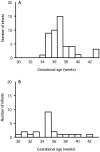Antibodies that inhibit Plasmodium falciparum adhesion to chondroitin sulfate A are associated with increased birth weight and the gestational age of newborns
- PMID: 14573685
- PMCID: PMC219546
- DOI: 10.1128/IAI.71.11.6620-6623.2003
Antibodies that inhibit Plasmodium falciparum adhesion to chondroitin sulfate A are associated with increased birth weight and the gestational age of newborns
Abstract
Antibodies that inhibit Plasmodium falciparum adhesion to the placental receptor chondroitin sulfate A are associated with a reduced risk of placental malaria, but whether these antibodies lead to improved pregnancy outcomes is unknown. We measured antiadhesion antibody levels in parturient women in western Kenya, where malaria transmission is intense. Secundigravid women with antiadhesion activity in their plasma delivered babies that were on average 398 g heavier (P = 0.019) and 2 weeks more mature (P = 0.002) than babies delivered to secundigravidas without antiadhesion activity. Our findings support the development of antiadhesion vaccines to prevent poor fetal outcomes due to pregnancy malaria.
Figures



References
-
- Bloland, P., L. Slutsker, R. W. Steketee, J. J. Wirima, D. L. Heymann, and J. G. Breman. 1996. Rates and risk factors for mortality during the first two years of life in rural Malawi. Am. J. Trop. Med. Hyg. 55:82-86. - PubMed
-
- Breman, J. G. 2001. The ears of the hippopotamus: manifestations, determinants, and estimates of the malaria burden. Am. J. Trop. Med. Hyg. 64:1-11. - PubMed
-
- Breman, J. G., A. Egan, and G. T. Keusch. 2001. The intolerable burden of malaria: a new look at the numbers. Am. J. Trop. Med. Hyg. 64:iv-vii. - PubMed
Publication types
MeSH terms
Substances
Grants and funding
LinkOut - more resources
Full Text Sources
Other Literature Sources
Medical

